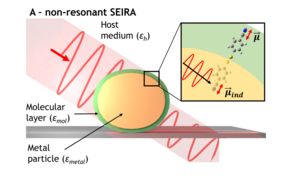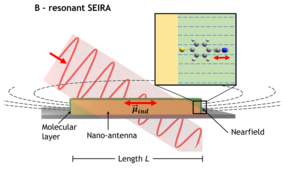What is “Seira”? It’s a city in Spain and a beautiful first name, but most importantly for this article, it is a surface sensitive spectroscopic technique. Jacek Kozuch, junior research group leader in the SFB 1078, Kenichi Ataka and UniSysCat group leader Joachim Heberle just published a Primer in Nature Reviews that describes in detail the underlying mechanisms and common methods to fabricate SEIRA-active materials. It also discusses the advantages, limitations, and applications of this powerful spectroscopic approach.
Understanding the Mechanisms
SEIRA (Surface-Enhanced Infrared Absorption) is a phenomenon observed when molecules are located at the interface of metals or metal oxides, resulting in an increase in their infrared spectral intensities.
Making SEIRA-active materials
There are different SEIRA-active materials for different applications. E.g. nanostructured coinage metal island films are fabricated to achieve a broad spectral enhancement over large surface areas. If you need something more tuned to specific narrow IR wavelengths, nanostencil lithography can be used to obtain nano-antennas. To avoid direct interaction of biological molecules with the metal surfaces, biocompatible functionalization of SEIRA-active materials can be applied.
Advantages, limitations, and applications
The SEIRA-active materials are used for sensitive molecular detection on surfaces, chemical analysis, in situ monitoring of reactions, and biophysical investigations. What makes it so powerful is the potential to detect even small trace amounts of certain molecules and the high sensitivity for minute alterations in molecular structures. In commonly used infrared spectroscopy, the detection limits can be relatively high, making it challenging to analyze small amounts of molecules or study surfaces with low absorbance. SEIRA spectroscopy overcomes these limitations by enhancing the infrared signals. When molecules of interest are adsorbed onto or near these nanostructures, their infrared absorption signals are significantly amplified, allowing for the detection and analysis of molecules at much lower concentrations and on surfaces that were previously difficult to study.
Particularly interesting for potential application in the area of research of UniSysCat, SEIRA has found applications in (spectro)electrochemistry and catalysis, enabling the study of chemical reactions and surface processes at the molecular level.




